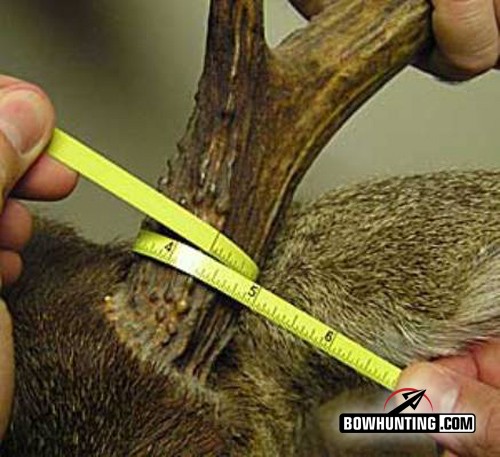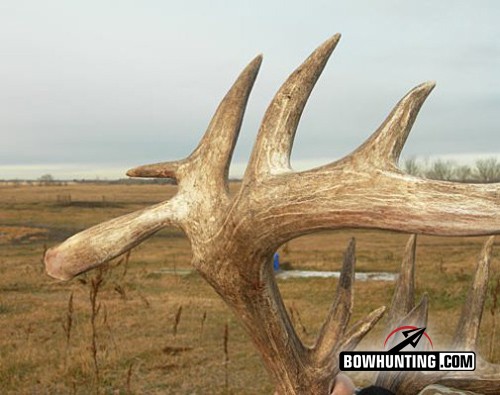LAST UPDATED: May 8th, 2015
Every time I talk to another whitetail hunter or see hunters write about the score of their buck, it’s extremely rare that they reference the net score, only the gross score. So, why do people reference the gross score rather than the net score? After all, if they were to enter the animal into the record book, only the net score would be recorded. Is it ego? Personally, I believe giving the gross score pays a lot more respect to the animal and gives it credit for what it grew. Basing the score off of a perfect rack just seems extremely absurd, from my eyes. Granted, I do feel that there should be separate categories for typical antlers and non-typical antlers, but in each of those categories, the animal should be given credit for what it grew. Shouldn’t they?!
History of Scoring
First, before we get into Net Score vs. Gross Score, it’s important to learn a little bit of history behind the purpose of scoring animals.
By the turn of the 19th Century, the future of many of North America’s big game animals was looking grim. In fact, many people believed that the final result of man’s settlement of the west would be the extinction of nearly all big game animals. In 1922 William T. Hornaday opened the National Collection of Heads and Horns at the Bronx Zoo in New York City. The collection was dedicated to “the vanishing big game animals of the world.”
With the conservation movement of the 1920s and the presence of the National Collection, interest grew in creating a records book and measuring of big game animals. In 1932, the Boone & Crockett club released its first big game records book titled, Records of North American Big Game. In 1939, it released its second edition of the book. In both of these publications the scoring system was very basic. Measurements consisted of the length of skull, or the length of the longer antler or horn, plus circumference of the base. In the case of Whitetail Deer, the longest beam would be measured and added to the circumference of the base. The obvious problem with this is, a one antlered deer could potentially score higher than one with both antlers.
With an obvious need for a better scoring system the Boone and Crocket club devised and released the current net scoring system in 1950 that is still used today. The current system uses measurements of beam length, tine length, mass and inside spread. A heavy emphasis is placed on symmetry and abnormalities are deducted from the final score. For example, if a tine on one side were longer than the matching tine on the other side, the difference would be subtracted from the gross, or total, score of the antlers. Also, if there were an abnormal point growing from the antlers, it would not be added in, but rather subtracted from the gross score.
This system of net scoring is currently being used by a number of big game records keeping clubs, including the Pope and Young Club, as well as many state clubs.
Measuring the antler base with a 1/4″ tape.
Real Life Situations
Every fall hunters across North America shoot some truly amazing whitetail bucks. Some of them easily make the record books, but some amazingly fall short. Lets examine a beautiful buck killed in 2009 by Bowhunting.com forum member Dan “Bloodcrick” Richardson, which at first glance, appears to be a shoe in for the record books.
Dan Richardson with his fantastic 2009 buck that only netted 118″ P&Y!
The following is a breakdown of the measurements of Dan’s buck. Included is the gross score, as well as the final net score.
Left Right Difference
MB 23 MB 21 1/8 1 7/8
G1 0 G1 3 4/8 3 4/8
G2 8 7/8 G2 12 1/8 3 2/8
G3 10 G3 7 3
G4 5 7/8 G4 2 3 7/8
H1 5 H1 5 1/8 1/8
H2 4 4/8 H2 5 2/8 6/8
H3 4 5/8 H3 4 1/8 4/8
H4 4 1/8 H4 3 1/8 1
Totals
Left 66 0/8
Right 63 3/8
Inside Spread 15 3/8
Typical Gross Score 144 6/8
Total side-to-side differences 17 7/8
Total abnormal 8 6/8
Final Net Score 118 1/8
Non-Typical Gross Score 153 4/8
Ok, lets be honest here. Who in their right mind would pass up a buck of this caliber? I know, for one, I would not. With a final net score of 118 1/8”, it falls far short of the minimum 125” to make the Pope and Young Club record books. Yet, even if this buck in question were to make the record book, rarely would his net score be referenced outside the pages of the book, only the gross score. If someone were to ask, without seeing a picture, most hunters would try to paint a true picture of how the buck looks. If it were my buck, I would describe it as a 153 4/8” 4×4 with an 8 6/8” sticker on his g2. Stating the net score would do this wonderful animal a disservice and show a lack of respect and what it grew for antlers.
Under both the P&Y and B&C scoring systems, these kicker points would be deducted from the buck’s score.
Is There a Better System?
I don’t know that there is a perfect system for measuring whitetail deer antlers, but I believe there is a much better one than the net scoring one that is widely used, the SCI (Safari Club International) scoring system. The system is simple, measure the antlers like you would in the net scoring system, but do not deduct the side-to-side differences. Yes, it’s that simple and it gives the animal full credit for what it grew. No penalizing the animal for asymmetry.
In the example of Dan’s buck above, it could be entered into the SCI record books in two ways. Its typical score would be 144 6/8 and its non-typical score would be 153 4/8. This system not only paints an accurate picture of the buck, but also respects what the animal grew.
So, next time you ask someone what their buck scores, remember, they will most likely be referencing the SCI scoring system, even if they don’t realize it. Or, if you ask about one of my bucks, I will point out that I am referencing the SCI system.
Author’s Note
One thing I would like to point out is that in no way do I believe the Boone and Crockett or Pope and Young Clubs are bad organizations. To the contrary, I firmly believe they are wonderful organizations and are champions of wildlife conservation and great advocates of hunters rights. I’m just a firm believer that their scoring system is not only out of date, but also out of touch with modern hunters and trophy hunters.







